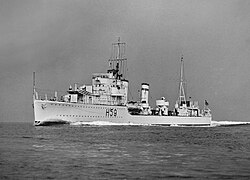HMS Gallant (H59)
|
The Gallant
|
||||||||||||||||||||||
|
||||||||||||||||||||||
|
||||||||||||||||||||||
|
||||||||||||||||||||||
|
||||||||||||||||||||||
HMS Gallant (H59) was a G-class destroyer of the British Royal Navy . During the Second World War , the destroyer was awarded the Battle Honors "Atlantic 1939", "Dunkirk 1940", "Spartivento 1940", "Mediterranean 1940–41" and " Malta Convoys 1941 ".
On January 10, 1941, the Gallant, southwest of Pantelleria, was hit by a mine and lost parts of the fore ship. The severely damaged destroyer was brought to Malta, where the destroyer was hit several times by bombs and on May 5, 1942, it was finally classified as no longer worth repairing.
History of the ship
The Gallant's keel was laid on September 15, 1934 at the Alexander Stephen and Sons shipyard in Linthouse near Govan in Scotland . The shipyard last delivered the destroyer Sardonyx to the Navy in July 1919 . The shipyard had received its first construction contract for destroyers for the Royal Navy in 1914 and manufactured fifteen destroyers for the Navy up to the aforementioned Sardonyx .
The Navy's third Gallant was launched on September 26, 1935 as the sixth unit of the class and entered service on February 25, 1936 as the fourth unit of the G-class.
Mission history
The destroyer was initially used together with its sister ships in the 1st destroyer flotilla in the Mediterranean Fleet . The Gallant was used several times during the Spanish Civil War off the Spanish Mediterranean coast as part of the so-called neutrality patrols. During one of these missions she was attacked on April 6, 1937 near Cabo de San Antonio by Spanish national planes, but not damaged.
War missions
When the Second World War broke out , the Gallant was with the 1st DF in the eastern Mediterranean. Her tasks after the start of the war included, in particular, securing convoy trains and warships. From 19 to 23 October she then moved to Great Britain with Glowworm , Grafton and Greyhound , where four more units of the flotilla followed a few days later.
The ship did not take part in missions during the campaign in Norway in connection with the landing of German troops there (Operation Weser Exercise ) because it was in the shipyard. At the end of May / beginning of June 1940 Gallant was used together with many other ships in the evacuation of the Allied troops encircled around Dunkirk ( Operation Dynamo ). On May 29, 1940, the ship was damaged by close hits by German bombers .
From July 1940, the destroyer was assigned as part of the 8th destroyer flotilla of Force H in Gibraltar . He escorted aircraft carriers several times that flew planes to Malta . In an extensive submarine hunt, which was made possible due to captured Italian secret documents, Gallant succeeded on October 20, 1940, together with Griffin and Hotspur , in sinking the Italian submarine Lafolè east of Gibraltar. Gallant secured cruisers and battleships for the Royal Navy in the battle of Cape Teulada .
The end of the Gallant
In early 1941, the destroyer participated in one of the escorting Malta - convoys part. He ran into a mine on January 10, 1941, southwest of Pantelleria . Because the ship was unable to maneuver, it had to be towed to Malta by the Mohawk .
There the Gallant was stranded because of the severe damage. A few days later and then again in April 1942, the ship suffered such severe further damage during air raids that it was classified as no longer worth repairing. In September 1943 the Gallant was sunk as a block ship.
literature
- Michael J. Whitley: Destroyers of World War Two. An international encyclopedia. Arms and Armor Press, London et al. 1988, ISBN 0-85368-910-5 .
